How to choose glue for tiles in the bathroom
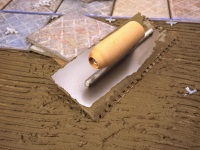
Ceramic tiles today - the most famous and popular material for repairs in the bathroom. Its variety of shapes, colors and textures will allow modern hostesses to realize all their fantasies. The beauty and undoubted practicality of tiles is obvious. When choosing the tiles you like, pay attention to one very important aspect - the adhesive on which it will be mounted.
Important nuances of glue selection
What should you pay attention to when choosing glue? Let's look into it. The bathroom is the most humid room in the house, which adds certain difficulties when choosing an adhesive mixture. Before going to the store for glue, you need to consider:
- On what basis will be attached to the tiles - plaster, old tiles, drywall, etc.
- Type of tile and its moisture absorption properties - it depends on how much glue it will absorb
- the area of one tilethe more, the thicker the layer of glue, which must be applied to it
- the size of the surfaceThe amount of glue on which the tile will be glued, an average of five kilograms per square meter.
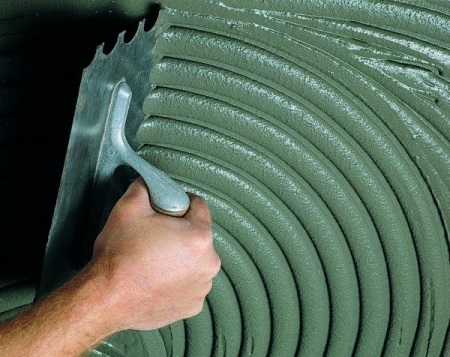
After evaluating all these parameters, we go to the store in search of the glue we need. So what kind of glue is a priority: dry or ready-made? It all depends on your requirements and the characteristics of the room in which the coating will take place. For example, in the bathroom experts recommend choosing dry, the basis is cement.
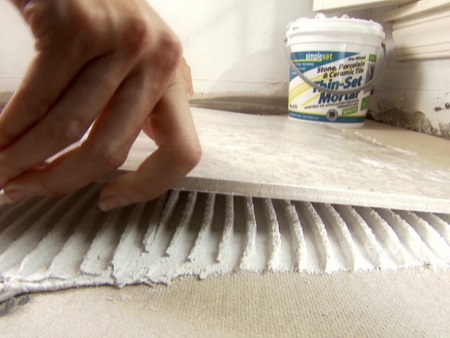
We have ready-made glue has one important point, it can only be applied to a perfectly smooth surface, and it costs a lot more. To date, dry glue is more popular, due to its availability and optimal combination of characteristics.
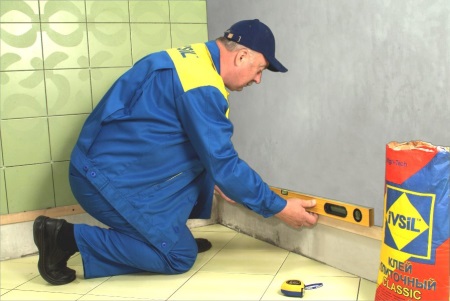
Properties and composition of the glue
Now let's take a closer look at the properties and compositions of adhesives. According to its composition, it is divided into three types: epoxy, cement, dispersion.
- Cement. Glue, the composition of which includes cement is quite universal. This is the most budget-friendly version of the glue, at the same time, it has a high bonding ability. It is based on about ninety percent cement. The proportion for diluting such a glue: three parts of glue, one part of water. It can be used on uneven surfaces.
- Dispersion. A mixture of acrylic, artificial resins and binders. This glue is best suited for surfaces coated with plasterboard. It is the worst for working with concrete, for example, it is not recommended to glue the tiles on the floor. Glue is available ready to work, packed in buckets, it saves time on dilution of glue.
- Epoxy. This two-component adhesive has three subspecies: flowable, paste with mineral filling and paste with ultra-fine filling. The fluid consistency of the adhesive gets into small cracks and improves the adhesion of the material to the surface. Wood, cement, concrete, metal, plywood, plastic and this is not a complete list of surfaces on which you can work with this type of glue.
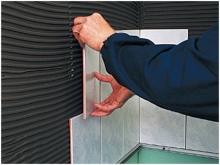
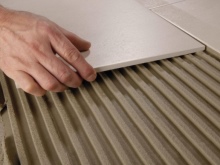
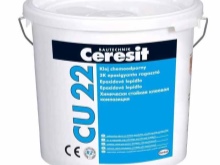
Choosing the right tile adhesive for the right size and material
When choosing an adhesive for ceramic tiles it is necessary to understand what size tiles you will glue. The larger the tile area, the higher the bonding properties of the adhesive with which it will be attached. It is good if the adhesive will include quartz sand and latex components.
Let's look at three varieties of tiles and glue that are optimal for each other:
- Mosaic. For its installation, you can use both cement-based adhesive and adhesive with a polymer base. Some manufacturers produce a special "super white" glue for laying mosaic.
- Porcelain stoneware. This finishing material has minimal moisture absorption, therefore, conventional glue is not suitable here. A good bond with the surface, elasticity and high glue, these are the three main factors, which should be guided when choosing a glue for porcelain tiles.
- Large-format tiles for flooring. Large tiles that are laid on the floor, it is recommended to attach a glue with high elasticity, it may be as cement-based adhesive, and glue with added polymers.
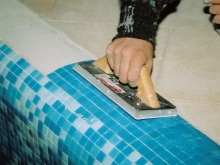
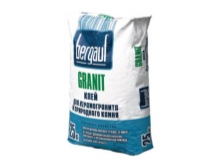
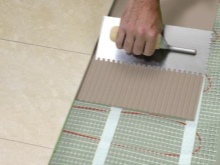
Advantages of dry adhesive compositions
Let's take a closer look at the most common type of adhesive, as dry cement-based mixes. The advantages of this type of adhesive are obvious. Dry tile adhesive can lay tiles on the walls, almost any curvature, without prior preparation of the working surface. The price of such a glue is several times lower, which is a big advantage. The glue will reliably hold your tile for 50 years, and during this time will bore any, even the most original tiles. Dry mixes have another advantage, with all the strength and reliability of the adhesive, if you decide to change the tile, the dismantling will not cost you much effort. The tile holds firmly, but at the same time, it is easy to dismantle if necessary.
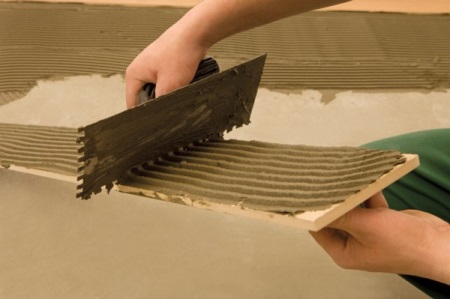
Liquid nails
I would especially like to highlight such an adhesive material as "liquid nails".. How appropriate their use when tiling with ceramic tiles? If you choose from the varieties of liquid nails, then when installing tiles is recommended to use - acrylic. We must take into account one peculiarity, in contrast to the adhesive mixes the use of liquid nails is no waterproofing. Use liquid nails, when installing tiles is possible in places where water does not fall.
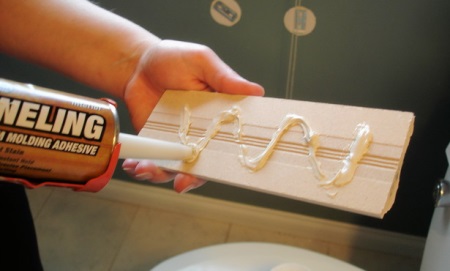
Liquid nails are convenient to use if the drawing is assembled of small parts, in the place of the wall, where water does not fall. In all other cases, we recommend using adhesive mixtures, they are more practical, versatile and significantly cheaper than liquid nails.
Universal adhesive
The main convenience of this glue is the possibility of its use both indoors and for facing on the street. But, it is recommended to use universal adhesive with caution.
This adhesive does not withstand heavy loads and is not suitable for fixing porcelain stoneware.
Its "universality" - a very relative concept. Tiles larger than 30x30 cm also can not be fixed with this adhesive. Experts recommend that you carefully consider the choice of adhesive and choose it based on your specific conditions, and not guided by the name.
Using an adhesive with reinforced properties in a room such as a bathroom, where all the finishing materials are subjected to constant stress, will be the most effective.
How to calculate the consumption of glue and tiles?
In any repair, it is worth paying special attention to the calculation of the amount of construction materials. Let's figure out how to correctly calculate the number of tiles for the bathroom. Let's start with the floor. There are three main ways of laying tiles on the floor:
- Tile is mounted with the edge along the walls
- tiles are mounted at a 45 degree angle to the wall
- diagonal-checkered, used when installing tiles with a pattern or consisting of several colors.
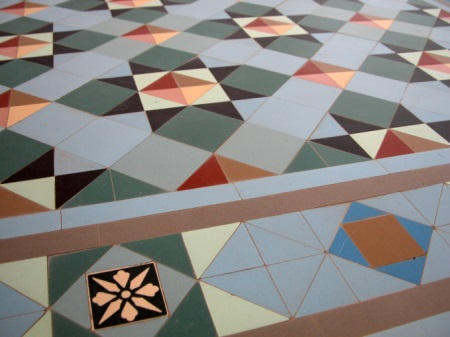
Here are the basic rules for the calculation:
- Determine the length and height of the surface to be tiled in centimeters
- Subtract the door and window, if any, from the size of the wall
- Measure the length and width of the floor in centimeters
- Choose the size of tiles to be laid on the floor and not on the walls
- count the result first in square meters, then, based on the size of the tiles, count the number of tiles in pieces.
Experts recommend buying 10-15% more tiles. During installation it will be necessary to cut the tile to fit the size, ceramic tile is a fragile material and you can not exclude its damage. Calculate the amount manually, without using on-line programs, they do not take into account many nuances.

Now we need to calculate how much glue we need for tile laying. To do this, you need to take into account several factors:
- Examine the substrate, the material it is made of and the number of irregularities on it. If the surface is relatively flat, if the indentations are up to 3 mm, the consumption of adhesive material is minimal. If the irregularities are deeper, the adhesive is also used as a leveling agent. There are special adhesive compositions for leveling walls. The same method is used when the back side of the tile has a pronounced relief, and the consumption of glue increases at times.
- The larger the area of the tile, the thicker the layer of adhesive is applied to it, from 2 mm in the size of 100x100 mm, to 4.5 mm in the size of 300x500 mm.
- Sometimes, when the thickness of several tiles in one picture is different, such a difference also needs to be leveled with glue.
- To calculate the necessary amount of glue, the total number of square meters of work surface is multiplied by the amount of glue needed to install the tiles per square meter.
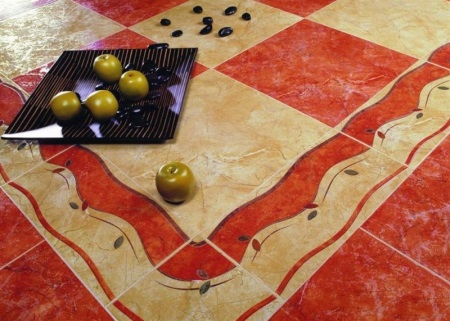
Paving with their own hands
Installing tiles, it requires certain skills. The price for such work in the market is quite high. The cost of laying one square meter by an experienced craftsman is usually equal to the cost of one square meter of tiles. Consequently, the more expensive the material, the more money will cost the work of the installer of tiles.
There are a few rules, adhering to which you will be able to master this process yourself:
- First, dilute the glue, as written in the instructions on the package.
- Tile installation goes from the floor to the ceiling.
- We measure the surface with a level and attach a lath to make sure everything is even.
- The first row of tiles is laid on it.
- Apply adhesive to the back of the tile with a notched trowel.
- Apply and press it to the wall, paying attention to evenly distribute the adhesive over the entire area.
- For equal distance between the tiles, use plastic crosses, which are removed before grouting the joints.
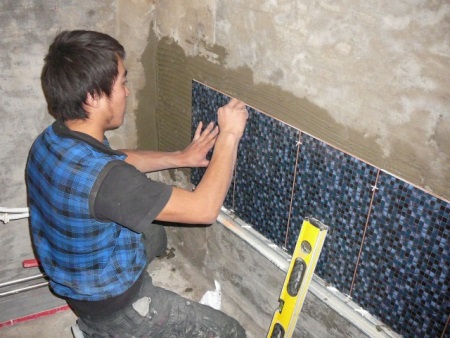
Watch a video on laying tiles with your own hands.
In the process of laying, the tiles have to be trimmed, for this there is a special tool - a tile cutter. It is easy enough to use, it is important to do all the measurements correctly before cutting off the desired part of the tile. The wall with the door is laid last. Protruding corners are closed with special plastic corners. Throughout the entire process, periodically control the quality of the laying with the level.
Grouting the joints is recommended after one day, after the end of the main tiling work. To do this, we advise you to use a rubber trowel, so as to close all the joints qualitatively and to prevent the penetration of moisture when using the bathroom. For the most effective moisture insulation, you can use special sealants. When choosing them, pay attention that the color of the sealant successfully combined with the color of the tiles. Technology for laying tiles on the floor has a similar technology. Start laying from the far corner, moving towards the door.
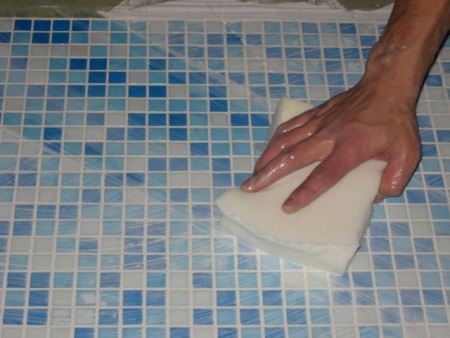
Prices and best manufacturers
Determining which adhesive mixture is the best is difficult. Often, it is a matter of habit, and as many masters, so many opinions. Different elasticity is perhaps the most basic difference between adhesives and each other. Let's list a few brands that have good characteristics among professionals: "Unis", Cerezit, "Starateli", "Mask" and others. Among the wide range of adhesives for tiles, everyone will be able to choose for themselves the most suitable brand for their requirements. We recommend not to overpay, and to pay attention to "economy" series, which meets all the standards that are now being applied to the glue bases.
We wish you an easy, fast and beautiful repair!
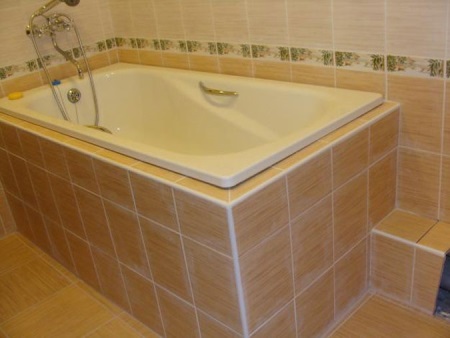





I'm going to put tiles on liquid nails (where there's no water around) and glue to make it go faster!